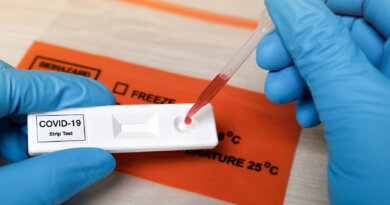Symptoms, Prognosis, Treatment & More – CanineJournal.com

What Is Degenerative Myelopathy?
Degenerative myelopathy (DM) is a hereditary adult-onset spinal cord disease similar to the human disease amyotrophic lateral sclerosis (ALS), more commonly known as Lou Gehrig’s disease. Dogs with DM experience slowly progressive weakness and an inability to control hind limbs, eventually leading to paralysis. Symptoms usually don’t begin until dogs are around 8 years old, but the range can be anywhere from 4-14 years old.
Breeds At High Risk For DM

Will My Dog Develop Degenerative Myelopathy?

We recommend several at-home DNA test kits that can identify factors that increase the risk of degenerative myelopathy: Embark, Wisdom Panel, and EasyDNA. See our reviews of the best dog DNA tests to see how they compare and what else you can learn about your dog through a DNA test.
Keep in mind that if your dog has the SOD1 mutation, it doesn’t mean that he’ll definitely develop DM. It just means he’s at a higher risk. But this knowledge can help your veterinarian with a more accurate diagnosis if your dog begins showing early symptoms.
Symptoms And Stages
Degenerative myelopathy symptoms usually progress over months and, in some cases, several years. DM typically doesn’t affect dogs mentally; they remain alert throughout the disease’s progression. Here’s how symptoms typically progress.
Early Stage
- Difficulty getting up from a lying position
- Hind end weakness (difficulty climbing stairs, going for walks, jumping onto furniture, etc.)
- Hindquarters appear to sway when standing still
- Dog falls over easily when pushed from the side
- Dragging the hind feet, causing the nails to look worn down
Intermediate Stage
- Knuckling of hind feet with a reluctance to put hind feet on the underside on the ground
- Difficulty supporting weight with hind legs
- Inability to walk without support
- Urinary incontinence
- Fecal incontinence
- Difficulty eating
- Change in the tone of barking
Advanced Stage
- Paralysis of hind legs
- Weakness in front legs
- Eventual paralysis in front legs
See A Video Of Symptoms As They Progress
This brief video shows you how degenerative myelopathy progresses through several stages. It helps you understand how the symptoms appear in dogs and what to expect over time with this disease.
Diagnosis

Veterinarians typically will conduct X-rays, CT, or MRI scans to rule out such conditions as arthritis, hip dysplasia, intervertebral disk disease (IVDD), tumors, trauma, or other issues that could cause weakness and mobility problems. Other tests may include tissue biopsies, cerebrospinal fluid (CSF) analysis, and neuromuscular tests. If your dog hasn’t already had a DNA health-risk test, your vet may conduct one for the SOD1 mutation to determine if that could be a cause.
Treatment And Prognosis
Unfortunately, there’s no medication or other treatment to cure or halt the progression of DM.
What’s the life expectancy of dogs with degenerative myelopathy? Dogs with DM typically live with the disease for anywhere from six months to three years, depending on when it’s diagnosed and how fast it progresses.

Veterinarians typically recommend physical therapy and often hydrotherapy. Some physical therapy exercises, like massages, can be performed at home. Your vet may also refer you to a canine rehabilitation specialist for your dog’s physical therapy.
A well-balanced diet will help to make sure that your dog continues to receive all of the nutrients he needs to stay healthy. You may want to consider switching to an all-natural fresh or healthier kibble dog food as another option to feed your dog a nutritious diet.
Some vets may also recommend a combination of supplements like vitamins B, C, and E, epsilon-aminocaproic acid, and N-acetyl cysteine; however, there’s no scientific evidence that they help slow the progression of the disease.
Because DM is a progressive disease and gets worse despite treatment, the prognosis for dogs with this disease is poor.
Our Personal Experience With DM
When Bella, our 12-year-old lab-mix, started dragging her feet on walks, we knew something was wrong. But, she had also been tender in her hip area for over a year, which we believed to be from arthritis, so we assumed it was related. When we took her to the vet for her walking difficulties, they gave her a laser treatment to reduce pain and inflammation from the suspected hip arthritis.
However, the next day, she was even worse. She couldn’t even get up to eat breakfast – her very favorite thing – so we knew her health was declining quickly. We rushed back to the vet, who was reasonably sure that Bella had DM. With no treatment options to cure her, only the ability to manage her pain while she continued to decline, sadly, we chose to say goodbye to Bella that day. You never know how long you have with your furry friends, so be sure to give them love every single day. – Michelle S., Canine Journal
Tools To Help Your Pup

Also, see our article on the best wheelchairs for dogs for our recommendations. These equipment options can help maintain your dog’s sense of independence and provide a better quality of life for the time he has left.
When Should I Consider Euthanizing My Dog With DM?
Euthanasia (humane death) is never an easy topic to discuss. When to put down a dog with degenerative myelopathy depends on each dog’s situation. Many people decide to euthanize their dog before the disease progresses into the front legs (eventually leading to total body paralysis) or before it leaves a dog unable to control his urination and bowel movements. This is a decision that you should discuss with your veterinarian. Your vet can’t make this decision for you, but they can help you in the decision-making process.
Does My Dog Have Another Condition?
As we said above, the early symptoms of degenerative myelopathy closely resemble some other conditions. You may want to learn more about arthritis and hip dysplasia in dogs to see if these conditions could be the cause of your dog’s mobility problems. But be sure to consult with your veterinarian to get the proper diagnosis and treatment plan.
What mobility problems is your dog experiencing?





Definitive journal of drugs and therapeutics. Get warning information here.
https://tadalafil1st.com/
Comprehensive side effect and adverse reaction information. Cautions.